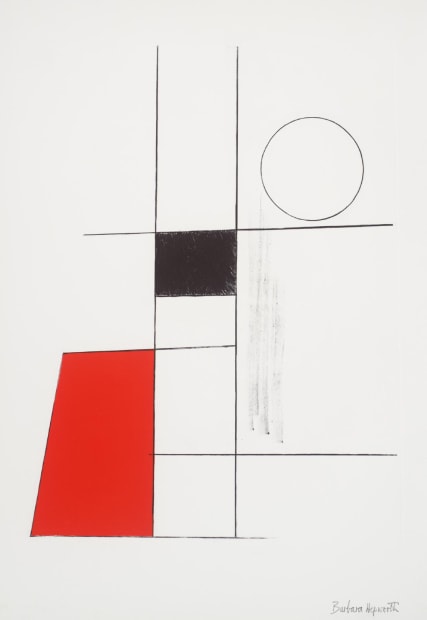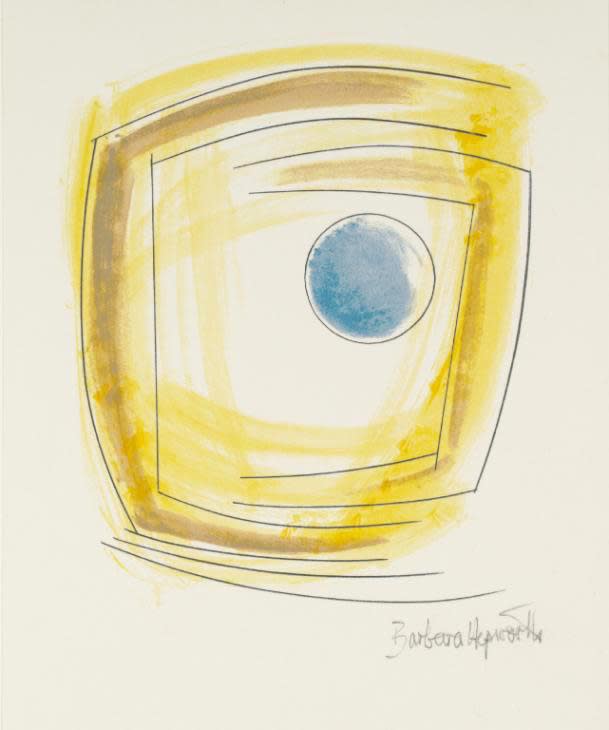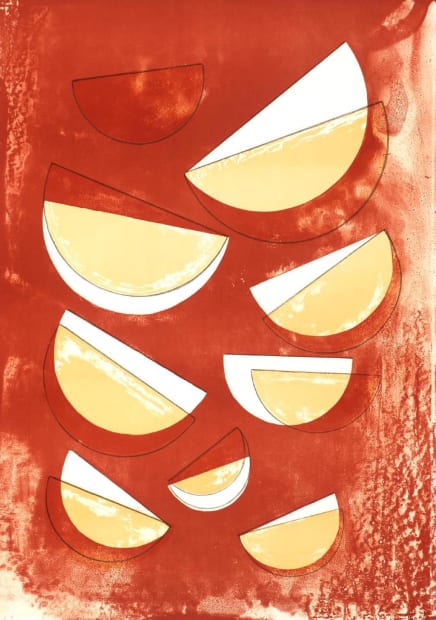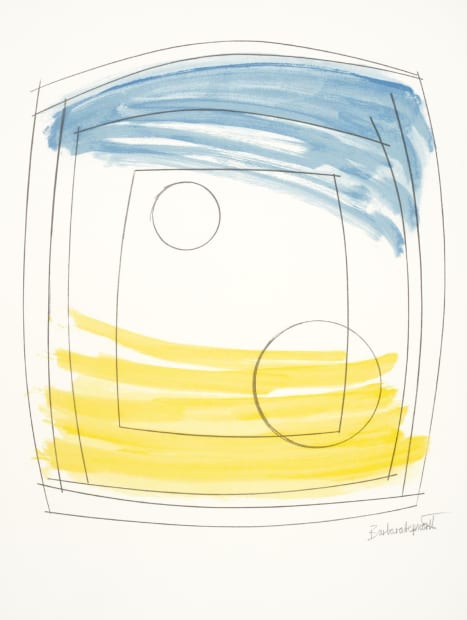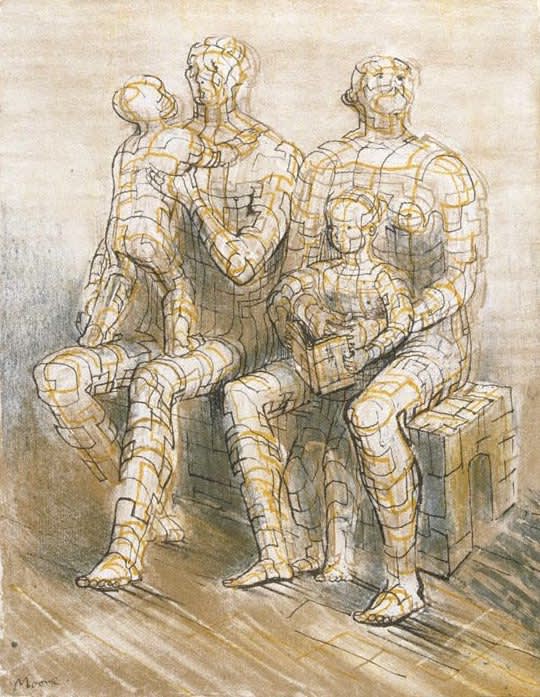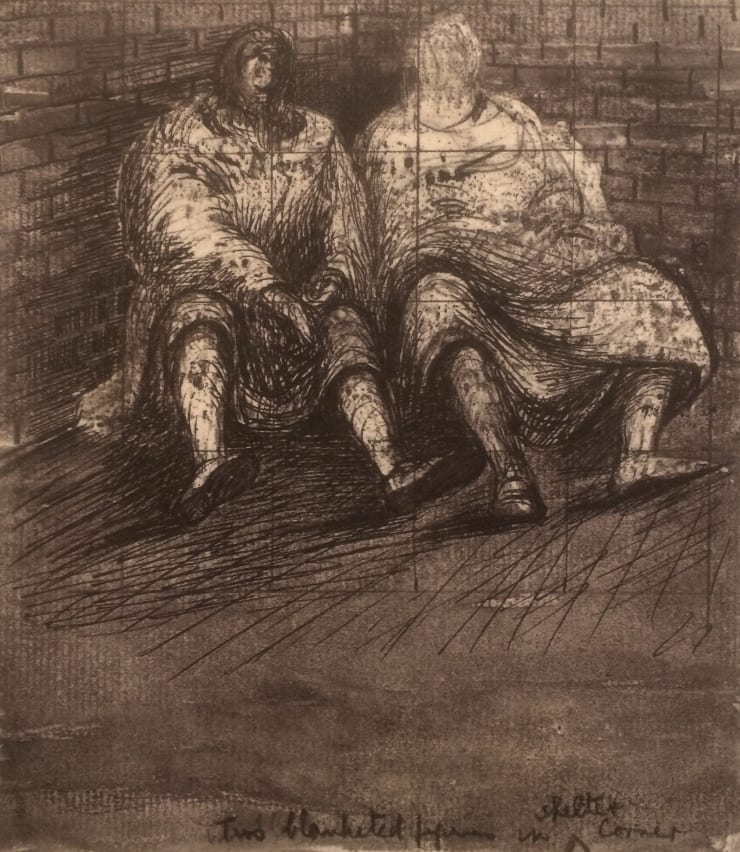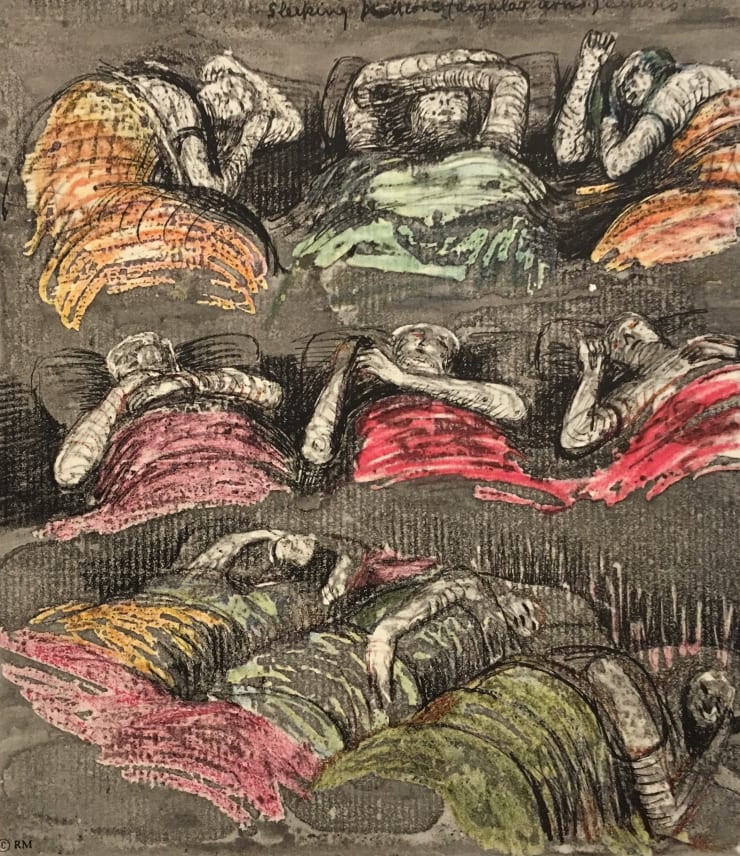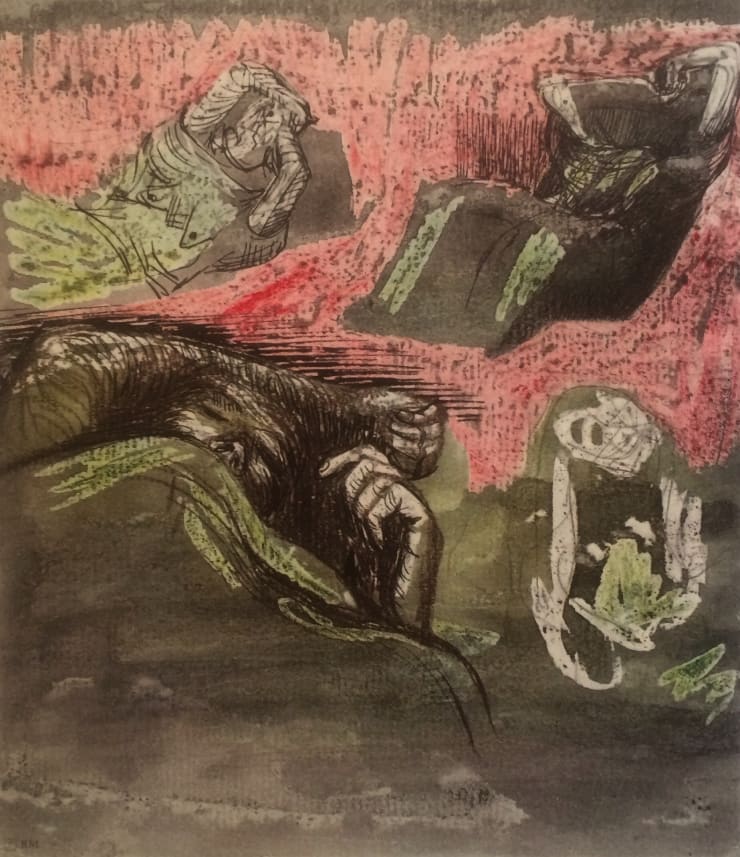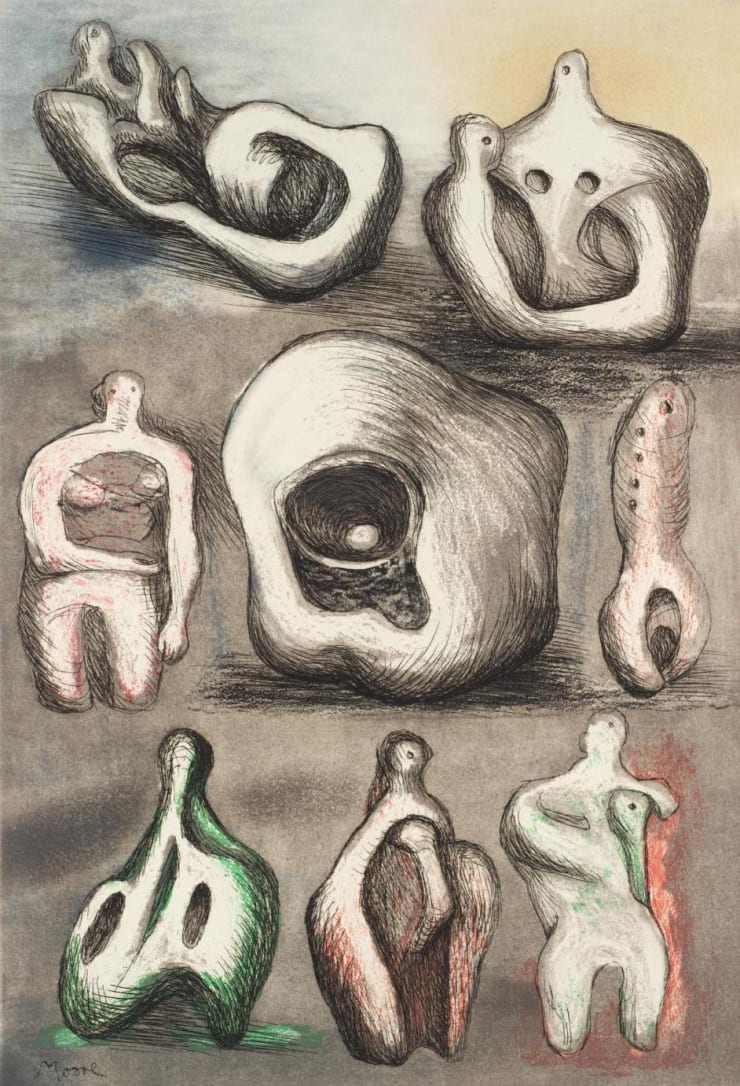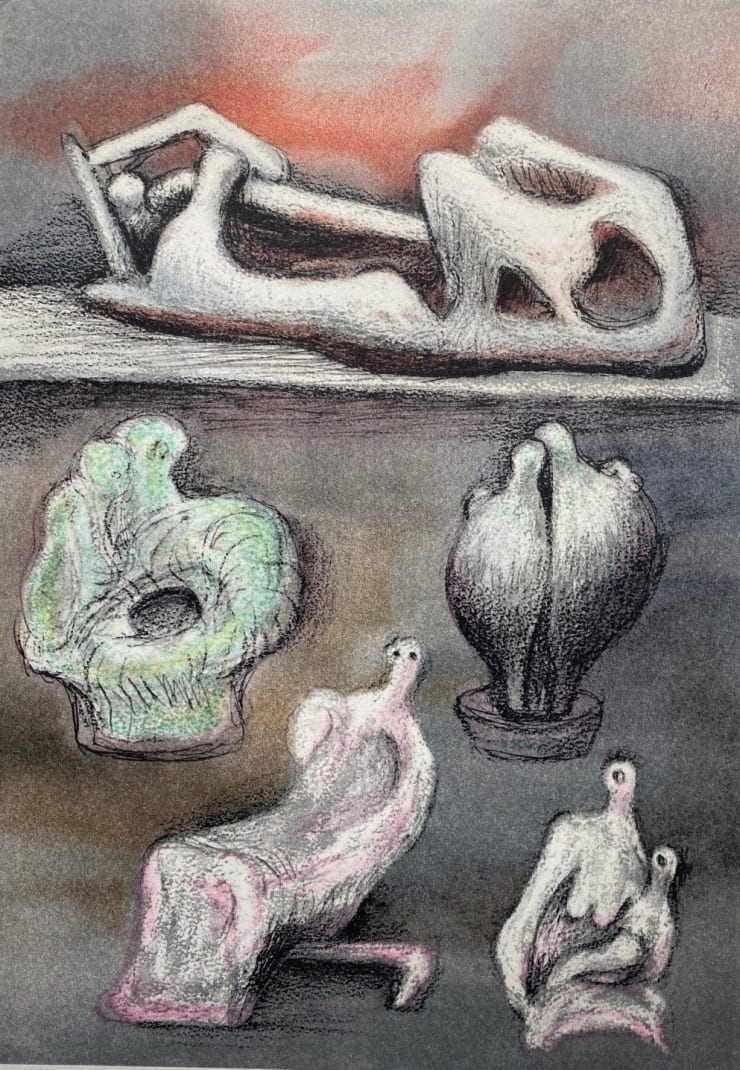Both sculpting and printmaking are tactile and collaborative artmaking techniques. While Barbara Hepworth and Henry Moore are best known as Britain’s preeminent modernist sculptors, this exhibition explores their mesmerising prints that showcase on a two- dimensional surface their skills in composition and colour. Differentiating them from other printmakers, the approach of these artists is essentially tactile, physical, and space-creating.
While the sculptures by these renowned artists are held in museum collections around the world, and are often beyond the usual art collector’s budget, their editioned prints are much more accessible, allowing visitors to this exhibition to take home an original work of art by Barbara Hepworth or Henry Moore.
-
Watch a short documentary OF
Barbara Hepworth & Henry Moore | Graphics
-

Barbara Hepworth, 'Mycenae' 1969
-
-
 Barbara HepworthMycenae, 1969Sold
Barbara HepworthMycenae, 1969Sold -
 Barbara HepworthAutumn Shadow, 1969Sold
Barbara HepworthAutumn Shadow, 1969Sold -
 Barbara HepworthThree Forms Assembling, 1968-1969Sold
Barbara HepworthThree Forms Assembling, 1968-1969Sold -
 Barbara Hepworth, Squares and Circles, 1969
Barbara Hepworth, Squares and Circles, 1969 -
 Barbara HepworthGreen Man, 1972Sold
Barbara HepworthGreen Man, 1972Sold -
 Barbara HepworthMoonplay, 1972£8,000.00
Barbara HepworthMoonplay, 1972£8,000.00 -
 Barbara HepworthWinter Solstice , 1971Sold
Barbara HepworthWinter Solstice , 1971Sold -
 Barbara Hepworth, Sea Forms, 1969
Barbara Hepworth, Sea Forms, 1969
-
-

Barbara Hepworth, 'Olympus' 1971
-
-
 Barbara Hepworth, Olympus, 1971
Barbara Hepworth, Olympus, 1971 -
 Barbara HepworthSun and Water , 1971Sold
Barbara HepworthSun and Water , 1971Sold -
 Barbara HepworthFragment, 1971£7,300.00
Barbara HepworthFragment, 1971£7,300.00 -
 Barbara HepworthDesert Forms, 1971£6,750.00
Barbara HepworthDesert Forms, 1971£6,750.00 -
 Barbara HepworthItea, 1971Sold
Barbara HepworthItea, 1971Sold -
 Barbara HepworthTwo Opposing Forms, 1970Sold
Barbara HepworthTwo Opposing Forms, 1970Sold -
 Barbara HepworthOrchid, 1970POA
Barbara HepworthOrchid, 1970POA -
 Barbara HepworthThree Forms, 1970Sold
Barbara HepworthThree Forms, 1970Sold
-
-

Barbara Hepworth, 'Moonplay' 1972
-

Henry Moore, 'Reclining Mother and Child' 1982
-
-
 Henry Moore, Mother and Child VI, 1983
Henry Moore, Mother and Child VI, 1983 -
 Henry MooreReclining Mother and Child with Blue Background, 1982£8,900.00
Henry MooreReclining Mother and Child with Blue Background, 1982£8,900.00 -
 Henry Moore, Girl Seated at Desk VI, 1974
Henry Moore, Girl Seated at Desk VI, 1974 -
 Henry MooreStanding Figures, 1949Sold
Henry MooreStanding Figures, 1949Sold -
 Henry Moore, Thirteen Standing Figures, 1958
Henry Moore, Thirteen Standing Figures, 1958 -
 Henry MooreWoman Holding Cat, 1949Sold
Henry MooreWoman Holding Cat, 1949Sold -
 Henry MooreFamily Group, 1950POA
Henry MooreFamily Group, 1950POA
-
-

Henry Moore, 'Two Seated Women' 1967
-
-
 Henry Moore, Two Seated Women, 1967
Henry Moore, Two Seated Women, 1967 -
 Henry Moore, Black Seated Figure on Orange Background, 1966
Henry Moore, Black Seated Figure on Orange Background, 1966 -
 Henry MooreUntitled XXXVII (Shelter Sketchbook) , 1967Sold
Henry MooreUntitled XXXVII (Shelter Sketchbook) , 1967Sold -
 Henry MooreUntitled XXXV (Shelter Sketchbook) , 1967Sold
Henry MooreUntitled XXXV (Shelter Sketchbook) , 1967Sold -
 Henry MooreUntitled XXXIX (Shelter Sketchbook), 1967Sold
Henry MooreUntitled XXXIX (Shelter Sketchbook), 1967Sold -
 Henry MooreUntitled LII (Shelter Sketchbook), 1967Sold
Henry MooreUntitled LII (Shelter Sketchbook), 1967Sold -
 Henry MooreUntitled LV (Shelter Sketchbook), 1967Sold
Henry MooreUntitled LV (Shelter Sketchbook), 1967Sold -
 Henry MooreUntitled LXV (Shelter Sketchbook), 1967Sold
Henry MooreUntitled LXV (Shelter Sketchbook), 1967Sold -
 Henry MooreUntitled XLIII (Shelter Sketchbook), 1967£280.00
Henry MooreUntitled XLIII (Shelter Sketchbook), 1967£280.00 -
 Henry MooreUntitled VII (Shelter Sketchbook), 1967£280.00
Henry MooreUntitled VII (Shelter Sketchbook), 1967£280.00 -
 Henry MooreUntitled XXVI (Shelter Sketchbook) , 1967£190.00
Henry MooreUntitled XXVI (Shelter Sketchbook) , 1967£190.00 -
 Henry MooreUntitled XXXVI (Shelter Sketchbook), 1967Sold
Henry MooreUntitled XXXVI (Shelter Sketchbook), 1967Sold -
 Henry MooreUntitled XXXVIII (Shelter Sketchbook) , 1967Sold
Henry MooreUntitled XXXVIII (Shelter Sketchbook) , 1967Sold -
 Henry MooreUntitled LXXV (Shelter Sketchbook) , 1967£190.00
Henry MooreUntitled LXXV (Shelter Sketchbook) , 1967£190.00
-
-

Henry Moore, 'Seven Sculpture Ideas II'
